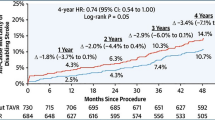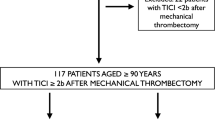Abstract
The objectives of this study are to explore the clinical effects of treatment with tirofiban for high-risk non-ST-segment elevation acute coronary syndrome (NSTE ACS) during peri-operative intervention operation period and to improve the level of clinical treatment. Ninety cases of high-risk NSTE ACS patients were randomly selected from January 2011 to April 2013 as the research objects, which were divided into two groups: the control group and the observation group. The control group received conventional aspirin, clopidogrel anticoagulation, coronary angiography, and percutaneous coronary interventional (PCI) treatment, while the observation group took tirofiban treatment in addition to the treatment of control group. The differences in major adverse cardiovascular events, TIMI flow grading, and complications of the two groups were observed after treatment. There were significant differences (P < 0.05) in the distal vascular blockage of major adverse cardiovascular events, intra-operative no-reflow, reoccurrence of acute myocardial infarction and stenocardia, and post-PCI TIMI flow grades 2 and 3. But in terms of bleeding complications, and TIMI flow grades 0 and 1 before PCI and after PCI, there was no significant difference (P > 0.05). Application of tirofiban treatment for high-risk NSTE ACS during the peri-intervention period is safe and effective, which can improve TIMI flow, increase tissue perfusion, and reduce postoperative complications.

Similar content being viewed by others
References
Bolognese, L., Falsini, G., Liistro, F., et al. (2006). Randomized comparison of upstream tirofiban versus downstream high bolus dose tirofiban or abciximab on tissue-level perfusion and troponin release in high-risk acute coronary syndromes treated with percutaneous coronary interventions: The everest tr[J]. Journal of the American College of Cardiology, 47(3), 522–528.
Ohman, E. M., Van de Werf, F., Antman, E. M., et al. (2005). Tenecteplase and tirofiban in ST-segment elevation acute myocardial infarction: Results of a randomized trial.[J]. The American Heart Journal, 150(1), 79–88.
Steen, H., Lehrke, S., & Wiegand, U. K. (2005). Very early cardiac magnetic resonance imaging for quantification of myocardial tissue perfusion in patients receiving tirofiban before percutaneous coronary intervention for ST-elevation myocardial infarction [J]. American Heart Journal, 149(03), 564.
Seitz, R. J., Oberstrass, H., Ringelstein, A., et al. (2011). Failed recovery from thrombolysis is predicted by the initial diffusion weighted imaging lesion.[J]. Cerebrovascular Diseases, 31(6), 580–587.
Liu, T., Xie, Y., Zhou, Y. J., et al. (2009). Effects of upstream tirofiban versus downstream tirofiban on myocardial damage and 180-day clinical outcomes in high-risk acute coronary syndromes patients undergoing percutaneous coronary interventions [J]. Chinese Medical Journal (English), 122(15), 1732–1737.
Valgimigli, M. (2010). Balancing safety and efficacy: Recent clinical evidence optimizing outcomes in patients with intermediate to high-risk non-ST-segment elevated acute coronary syndrome [J]. European Heart Journal Supplements, 12(Suppl.D), D14–D23.
Li, J.-P., Liu, Q., Huo, Y., et al. (2013). Rationale and design of the ETN-STEP (Early administration of tirofiban in mid to high risk patients with non-ST elevation acute coronary syndrome referred for percutaneous coronary intervention) project: A multi-center, randomized, controlled clinic trial in Chinese patients [J]. Journal of Geriatric Cardiology, 9(4), 375.
Schwenkglenks, M., Brazier, J. E., Szucs, T. D., et al. (2011). Cost-effectiveness of bivalirudin versus heparin plus glycoprotein IIb/IIIa inhibitor in the treatment of non-ST-segment elevation acute coronary syndromes [J]. Value in Health, 14(1), 24–33.
Harrington, R. A., Becker, R. C., Cannon, C. P., et al. (2008). Antithrombotic therapy for non-ST-segment elevation acute coronary syndromes: American college of chest physicians evidence-based clinical practice guidelines (8th edition).[J]. Chest, 133(6 SUPPL), 670S–707S.
Harrington, R. A., Becker, R. C., Cannon, C. P., et al. (2008). Antithrombotic therapy for non-ST-segment elevation acute coronary syndromes: American college of chest physicians evidence-based clinical practice guidelines (8th edition).[J]. Chest, 133(6 SUPPL), 670S–707S.
Author information
Authors and Affiliations
Corresponding author
Rights and permissions
About this article
Cite this article
Liu, N., Hou, M., Ren, W. et al. Clinical Research of Treatment with Tirofiban for High-Risk Non-ST-Segment Elevation Acute Coronary Syndrome During Peri-Operative Intervention Operation Period. Cell Biochem Biophys 71, 43–47 (2015). https://doi.org/10.1007/s12013-014-0160-9
Published:
Issue Date:
DOI: https://doi.org/10.1007/s12013-014-0160-9




